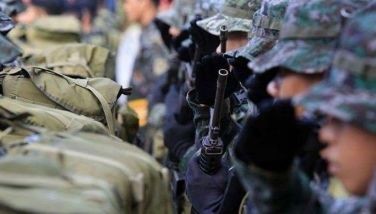DAR extends help to non-CARP farmers
September 4, 2002 | 12:00am
Agrarian Reform Secretary Hernani Braganza is giving non-beneficiaries of the Comprehensive Agrarian Reform Program (CARP) a chance to improve their lives through the adoption of an innovative scheme called Bayanihan Agrarian Reform Zones (BAR zones).
Braganza gave the assurance to reach out not only to former-beneficiaries, but also to non-CARP farmers by implementing the principles of BAR zones in non-agrarian reform communities (ARCs).
He explained for the first time, farmers in non-ARCs would have the equal opportunity to receive support services from the Department of Agrarian Reform (DAR).
A BAR zone shall serve as a convergence area for discussion, consultation, planning, operation and reforms to be instituted by DAR, other CARP-implementing agencies, local government units, people’s and non-government organizations, the private sector and farmers.
The approach, which was conceptualized in 1993 and patterned after ARCs, would pave the way for ARCs and non-ARCs to merge and share with one another whatever support services they have within a delineated area called the BAR zone.
Its main objective is to maximize the delivery of support services, such as technical assistance and infrastructure, which could be useful to both non-CARP farmers and farmer-beneficiaries.
Braganza instructed DAR personnel to identify potential sites for BAR zones and to put up superimposed map overlays in all municipalities to distinguish boundaries of the proposed BAR zones within the provinces.
Map overlays would determine if the area is for agricultural use, land use, major crops, CARP coverage, political boundary of congressional districts, and ARC site.
Braganza gave the assurance to reach out not only to former-beneficiaries, but also to non-CARP farmers by implementing the principles of BAR zones in non-agrarian reform communities (ARCs).
He explained for the first time, farmers in non-ARCs would have the equal opportunity to receive support services from the Department of Agrarian Reform (DAR).
A BAR zone shall serve as a convergence area for discussion, consultation, planning, operation and reforms to be instituted by DAR, other CARP-implementing agencies, local government units, people’s and non-government organizations, the private sector and farmers.
The approach, which was conceptualized in 1993 and patterned after ARCs, would pave the way for ARCs and non-ARCs to merge and share with one another whatever support services they have within a delineated area called the BAR zone.
Its main objective is to maximize the delivery of support services, such as technical assistance and infrastructure, which could be useful to both non-CARP farmers and farmer-beneficiaries.
Braganza instructed DAR personnel to identify potential sites for BAR zones and to put up superimposed map overlays in all municipalities to distinguish boundaries of the proposed BAR zones within the provinces.
Map overlays would determine if the area is for agricultural use, land use, major crops, CARP coverage, political boundary of congressional districts, and ARC site.
BrandSpace Articles
<
>
- Latest
- Trending
Trending
Latest






























